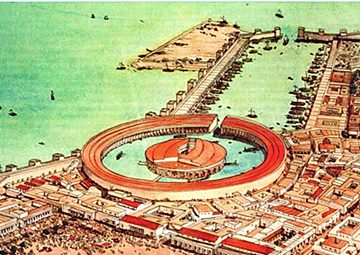
Capture of Carthage |
year: 698Spring 698 |
| The Arabs captured Carthage and destroyed it | ★ ★ ★ ★ ★ |
|
enemy: Arabs (Umayyads)
|
location: Ancient Carthage
|
accuracy:
●●●●●
|
|
battle type: City Capture |
war: Muslim Conquest of North Africa |
modern country:
Tunisia |
| ▼ The Byzantines(emperor: Leontios) | ▼ The Enemies | |
| Commander: | Ioannes the Patrician | Hassan Ibn al Nu’man |
| Forces: | outnumbered | 40,000 |
| Losses: | Minimal | Heavy |
| Background story: |
| After the conquest of Egypt, the Arabs made a first serious attempt to expand to the rest of North Africa in 647, and gained control of most parts of what used to be the Byzantine Exarchate of Africa. They came back in 665 and until 689 they conquered all North Africa. During this turbulent period, Carthage remained a Byzantine city. However the exarchate was in a situation of uncertainty and permanent crisis, as it became a semi-client state attempting to maintain tributary status with Constantinople and the Arabs, an effort that strained the resources of the Exarchate and caused unrest amongst the population. In 697, the Exarchate of Africa was finally overrun by the appointed governor of the Magreb Hassan Ibn al Nu’man who took Carthage with an army of 40,000 men almost without resistance. After this quick success, Hassan continued his expedition to other Maghreb territories and left. The fall of Carthage was a major loss. Emperor Leontius sent a navy force under the command of John the Patrician and the droungarios (head of the fleet) Tiberius Apsimarus. The Byzantine fleet entered the harbor and in a stunning surprise attack recaptured the city. The Arab garrison fled. As Gibbon writes, “the Christians landed; the citizens hailed the ensign of the cross, and the winter was idly wasted in the dream of victory or deliverance.” |
The Battle: |
 Carthage In the spring, the Arabs launched a general assault by sea and land/ Hasan ibn al-Numan, enraged after the humiliating take over by the Greeks, offered no terms except to surrender or die. The Emperor Leontios, infamous for his harsh reaction to failure, had also given his forces instructions of victory or death. The Romans, at some point, made an exit and attacked the Emir’s army directly, but were defeated, and Ioannes decided to wait out the siege behind the walls of Carthage to let the Arabs exhaust themselves, since he could continue to be resupplied from the sea. But the defenders were faced with Hasan’s overwhelming force deployed in ferocious attacks as his men made repeated attempts to scale the walls with ladders. They combined this land assault with an attack from the sea. So, the Byzantines could not hold any longer and withdrew from the city. What followed was the second and final great destruction of Carthage. The Christians retreated to the islands of Corsica, Sicily and Crete. The Arabs slaughtered the civilians, totally destroyed the city and burned it to the ground, leaving the area desolate for the next two centuries. Ioannes the Patrician was later murdered after a conspiracy at the hands of his naval commander, Tiberius Apsimarus. |
Noteworthy: |
| Tiberius Apsimarus then, instead of taking the step of returning to Africa to fight the Muslims, sailed to Constantinople. After a successful rebellion, he rose to the throne as Tiberius III. |
Aftermath: |
| After this battle, the Arab domination of North Africa was unchallenged. The Byzantines never came back. Carthage was destroyed and its glorious history was over. |
|
|
